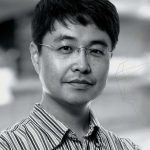OBSERVATIONS Sung Han was destined for Salk
That’s how it feels, anyway, when he reflects on the myriad unexpected connections he’s had to the Institute since he first heard about it 17 years ago. In 2000, Han was a research scientist at a biotech company in his native South Korea. The company, LG Life Sciences, Ltd., had built a new R&D facility that was awarded best design in Korea. The design, Han learned at the time, was inspired by the work of an American architect named Louis Kahn who had designed a world-renowned edifice in California called the Salk Institute. Han could not have imagined, gazing at the LG building’s concrete facades and study towers, that close to two decades later he would call Salk home.
Han, an assistant professor in the Clayton Foundation Laboratories for Peptide Biology, arrived at the Institute a year ago to study how the brain recognizes aversive sensory signals. For example, laboratory mice that have never been exposed to predators will still cower at the smell of a fox or the sound of a hawk, suggesting that brain circuitry devoted to parsing threats is innate, not learned. Han wants to understand the way such circuitry is genetically encoded and how it operates, because when these alarm systems are not functioning properly humans can suffer from neuropsychiatric conditions like panic disorder, migraine or autism.
Inside Salk sat down with Han to talk about how he came to the Institute, what he hopes to accomplish with his research and—despite the many simultaneous demands of getting a new lab off the ground—how he manages to recharge.
You first heard about Salk because of the new building at LG. What are some of the other times you heard about the Institute prior to becoming a faculty member here?
My first project at LG was in endocrinology, looking for a natural product that would secrete growth hormone. When I conducted background research for the project, I learned that Nobel laureate and Salk Professor Roger Guillemin discovered the molecule the brain releases to trigger the secretion of such hormones. [Guillemin came to Salk in 1970 to head the new Laboratories for Endocrinology.]
I noticed the name, but forgot about it until many years later, when I was applying to jobs after completing my postdoctoral training. I saw a position at Salk, applied and was invited to come and give a talk. I almost didn’t make it, because I had an attack of vertigo from Meniere’s disease the night before I had to travel for the interview. The next morning, I was about to email Alan Saghatelian and tell him I couldn’t come but then decided, ‘I’ll give it one more hour.’ The attack cleared up and I was able to travel. It felt like a miracle.
Another funny coincidence is that my main research project is related to a protein called CGRP, and in my job interview I learned the protein was discovered by Salk Professor Ron Evans! After I joined the Institute, I realized this is the ideal place for me as a junior faculty member. I am very inspired by Ed Callaway’s neuroscience research—I’m doing something similar—and his office is right down the hall from mine.

What are you working on?
I’m working on three different projects, all related to the sensory encoding of aversive information. One is on migraine, another is on panic disorder and the third is on autism spectrum disorder. All three share similar symptoms, such as sensory hypersensitivity. Most migraine sufferers are very sensitive to light and sound, and sometimes even smell. People with autism are very sensitive to sounds that normal people don’t notice. They can also be very picky eaters who are sensitive to touch and smell. Normal sensory stimuli are aversive to them, which I find very interesting.
How do you study these aversive stimuli?
I focus on a brain region called the brainstem. Thirty or forty years ago it was a very popular area for neuroscience, but then people started to focus on higher brain areas. But I think it’s important to look at this area for encoding aversive signals to the brain. It’s hard to study because it’s very small, and lots of different cell types are intermingled, but I use recently developed cell type–specific tools. We have animal models for all three disorders and I use molecular and electrophysiological tools to study the neurocircuits involved and check whether they are dysfunctional.
Today is a golden age for studying neural circuits. We have tools to manipulate specific populations of neurons, selectively activating or deactivating them. Years ago, Francis Crick said that to understand how the brain works, you need to be able to manipulate and monitor—as well as to map—the anatomical connections only in certain types of neurons, leaving others unaltered. Later, Ed Callaway’s lab modified the rabies virus to beautifully develop the tool Crick predicted would be needed. Now we can specifically manipulate, map and monitor the neural circuit. I can manipulate certain populations of neurons using light and check behavior outcomes and activity in awake, behaving animals. All these newly developed tools also make it possible to monitor specific neuronal populations in specific brain areas while animals perform specific behaviors. It’s incredible.
You have such a historical awareness about science— did you always want to be a scientist?
My father was a veteran of the Vietnam War and he had PTSD. I often saw him having seizures, and initially I wanted to be a doctor to cure his symptoms. But when I was a student, I had the realization that even though doctors take care of patients, cures come from research. So I decided to change direction and become a researcher.
In graduate school I studied epilepsy, but I also got interested in autism because the two disorders often go together. And from that my interest moved specifically to neural circuits because to understand brain disorders you really need to know how the brain works.
What do you find most challenging about your research?
Failure of an experiment can be quite frustrating. But that can be compensated for by an experiment that succeeds or by data that supports a hypothesis. I don’t want to bring lab work home, so when I leave I try to focus on my family.
I like cooking. Research experiments fail all the time—9 times out of 10. But cooking doesn’t suddenly fail. As long as I follow the recipe, I can achieve a certain degree of flavor and my wife and kids really like my dishes, which is very rewarding.
What do you cook?
Well, Korean food, certainly—Korean barbecue or soups. There’s a large Korean community in San Diego, so it’s not hard to get the right ingredients. That’s one of the reasons I chose to move to San Diego. I got my PhD in Seattle and also did my postdoctoral training there. We lived in Seattle for 10 years and my kids didn’t want to leave their friends or their school. But it didn’t take long for them to settle down here. In fact, I had a chance to go to Seattle recently and asked the family if they wanted to join me, and they didn’t want to! They now like San Diego better.
Support a legacy where cures begin.
Featured Stories
 Harnessing plants for the futureGet ready, sunny San Diego: Winter is coming. We’re not talking about a new season of Game of Thrones—although the story is one of epic proportions and high stakes.
Harnessing plants for the futureGet ready, sunny San Diego: Winter is coming. We’re not talking about a new season of Game of Thrones—although the story is one of epic proportions and high stakes. Sung Han was destined for SalkHan, an assistant professor in the Clayton Foundation Laboratories for Peptide Biology, arrived at the Institute a year ago to study how the brain recognizes aversive sensory signals.
Sung Han was destined for SalkHan, an assistant professor in the Clayton Foundation Laboratories for Peptide Biology, arrived at the Institute a year ago to study how the brain recognizes aversive sensory signals.  All roads lead to science for Elena Blanco-SuárezFrom early on, it was pretty much a given that Elena Blanco-Suárez would be a scientist.
All roads lead to science for Elena Blanco-SuárezFrom early on, it was pretty much a given that Elena Blanco-Suárez would be a scientist.




















































